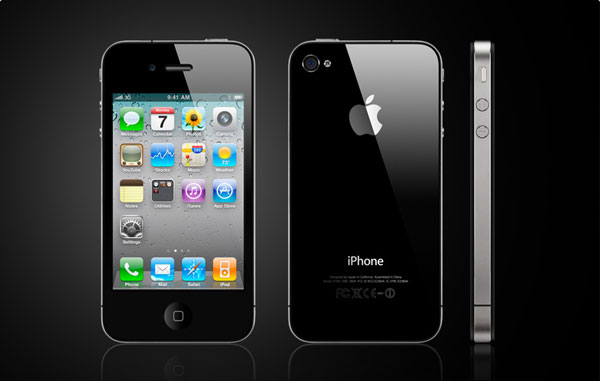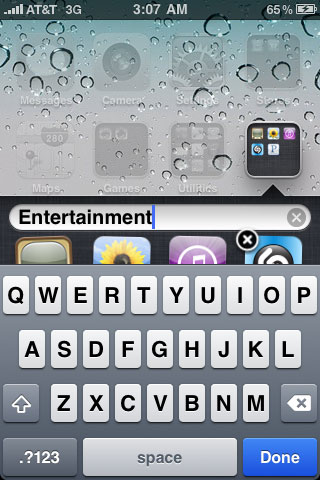Apple's iOS 4 Explored
by Anand Lal Shimpi on June 22, 2010 3:27 AM EST- Posted in
- Smartphones
- Apple
- iOS 4
- Gadgets
- Mobile
Steve Jobs stood on stage and proclaimed the iPhone 4 would be the biggest advancement since the introduction of the original iPhone. It’s a bit of a self fulfilling prophecy. Steve says it, folks get extra excited, and pre-orders go through the roof.
Granted it’s not all fluff. The faster SoC, smaller size and new industrial design are usually enough to sell a smartphone, much less a new iPhone. But add in a ridiculously high resolution display and you’ve got the potential for cool.

Yesterday the pre-launch festivities began with the official release of the fourth version of Apple’s mobile operating system: iOS. The new release, dubbed iOS 4, is available for the iPhone 3G, 3GS and iPhone 4 although it only offers the full set of features on the iPhone 3GS and iPhone 4. Unfortunately iPad users will have to wait until this fall to get the update.
The biggest features from an end user standpoint are the introduction of folders as a way of grouping apps together and simplifying your the iOS interface and of course, multitasking.
Folders
On my iPhone I have five screens of apps. That’s ridiculous. And as odd as this sounds, I can never find the flashlight app when I need it. When the iPhone 3G came out I mentioned that the simplicity of the iOS was being jeopardized. With apps and the new functionality Apple was trying to enable, everything got more cluttered. The original iPhone was a success due to how clean and efficient its UI was. While I believe that iOS3 still has the edge there, it’s one that is quickly eroding.
Folders is Apple’s temporary solution to the problem, and it seems to work. Press and hold your finger over an app icon on your home screen, wait for the icons to start jiggling, and then move one icon over another one. The two will form a group called a Folder and the Folder will be automatically named based on the type of apps in it. You can also rename the Folder.

A Folder in iOS 4

Renaming a Folder
With a bit of organization, I could reduce my five screens of apps down to two. With some pruning of unnecessary apps I got it down to one. Much better.

Like many features in iOS 4, Folders are both an improvement and a burden. The burden comes from the fact that you now have to tap, wait for a folder expansion animation and then tap again to launch an app in a folder. Folders also remain “open” until they’re closed. Meaning if you launch an app in a folder, when you return to the home screen you’ll actually end up in the last folder you were in. Hit the home button a second time to actually get to the home screen. I suspect this is a bug that Apple will fix however.
It’s also very easy to forget what you put in each Folder (you can store a maximum of 12 apps in a Folder). The Folders all look the same and although they give you a little preview of what’s inside it’s often difficult to tell. I’ve found that the best solution for me is to keep frequently used apps directly on the home screen but put everything else in Folders. Keeping everything on a single home screen also really helps keep things tidy and efficient. If you do have a ton of apps and can’t remember what folders you put them in, the Spotlight search is probably going to be even more important to you now than it has ever been.
I called Folders a temporary solution to the problem because eventually Apple will have to come up with new ways to deal with app and data organization, not to mention task switching. None of the features that show up in iOS should be a surprise, we’re seeing a repeat of the history of the PC, just in revised form. Apple and Google (eventually Microsoft as well) are looking to recreate the evolution of the PC not just in hardware but software as well, but they’re looking to do it without the mistakes. That’s why Apple is so adamant about defending its closed platform.
When we get true multitasking and once these mobile devices turn into active productivity devices rather than passive consumption devices then we’ll need much more than Folders. Remember the first time you saw the Start menu? You’ll probably get a similar feeling in the next few years on a smartphone OS.










46 Comments
View All Comments
rallstarz - Tuesday, June 22, 2010 - link
Forgive me for peeking at your email Anand, but I'd be excited about a fro-yo review on anandtech.... maybe fro-yo making machines, fro-yo flash freezers, fro-yo dispensers...Stuka87 - Tuesday, June 22, 2010 - link
Over all I like the upgrade. My phone feels more snapping in several areas (3GS). However, I have two big issues.1: In Mail, I want a "Mark All Read" option. I tgets *SO* old having to go through 30-40 emails because I read them on another device. Not an issue with my Exchange mail, but is a major issue with my POP3 mail.
2: I wish I could exclude some apps from multi tasking. Because now I find myself running 4-5 apps at the same time. And most of them are apps that don't need two. Like weather, or calculator. I would love it if I could say "Dont ever multi-task this app". The same could be applied to some games.
metafor - Tuesday, June 22, 2010 - link
"We still need faster SoCs and more power efficient platforms to make multitasking work on smartphones. I say faster SoCs because one of the best ways to improve power efficiency is to complete tasks quicker so that the CPU can return to an idle state.Because current smartphone SoCs don’t have the level of performance needed to quickly execute a ton of extra instructions and get back to sleep, smartphone OSes have to keep background tasks to a minimum. For the most part you don’t have to worry about what applications you have open on your notebook, your CPU is efficient enough and you have enough battery power to churn through any instructions idle apps may be throwing at it. We’re not quite there yet in smartphones."
I'm afraid this isn't true. The only difference between a netbook processor and a smartphone processor is that the former is running off of a relatively honking battery. Having the CPU "finish the task faster" is absolutely not a power advantage.
Let's break down the 2 main areas of power usage for a CPU:
1. Leakage. Here, you can make the argument that if a CPU is active longer, it suffers more total energy that is leaked between VDD and GND. However, this is almost entirely offset and in most cases overshadowed by the fact that a faster CPU (running either at a higher frequency, has more parallel execution resources, or runs on faster transistors) will always be significantly leakier than their slower counterparts. Leakage increases with the square of voltage and as everyone will tell you, when a CPU ramps up in frequency, it will scale up its voltage.
2. Dynamic current. This only gets worse at faster frequencies. Whether you're charging/discharging 500 million times a second (500MHz) or 1 billion times a second (1GHz), the same tasks requires the same number of charges/discharges whether it happens in 1 second or 2 seconds. The same amount of energy to perform the work is used. However, as mentioned before, to make a chip run faster, you'll have to also up the voltage and/or use leakier (but faster) transistors.
In fact, the argument for dual-core being more power efficient is that in the case where 2 cores running at 500MHz doing the same amount of work (assuming you're running, say, 2 tasks that would otherwise be context switched in the same CPU) as 1 core at 1 GHz, the 2-core solution would draw less power since a core running at 500MHz uses less than half the power of a 1GHz core.
You are absolutely right in that the limitations of multitasking has to due with power efficient CPU's and it is a compelling argument for multi-core cell phone SoC's and perhaps even heterogeneous multi-core SoC's. Luckily, we'll be seeing those soon enough in the next year or so.
Matt Campbell - Tuesday, June 22, 2010 - link
Angry Birds is a great game - but why do you have both the Lite and Full version installed in the screen shot? :)So far, my biggest likes of iOS4 are the responsiveness (3GS definitely feels faster) and the email threads, which really help on my Exchange account. I read a lot of eBooks on Stanza and will probably stick with that for the short term.
SunSamurai - Friday, June 25, 2010 - link
Because he tried it before he buyed it? ;)Polizei - Tuesday, June 22, 2010 - link
I love that Anand is bumpin the 50 cent during his Iphone interview. Funny choice :Dsynaesthetic - Tuesday, June 22, 2010 - link
Anyone know if these ads show up on the iPod touch 3G upgraded to iOS 4?If so I probably won't buy a Touch...
I don't understand why *anyone* would prefer ads to paying more for software. Seriously, it's not worth it to me. TV commercials are bad enough.
SunSamurai - Friday, June 25, 2010 - link
You dont understand why people dont want to spend money when they dont have to?jasperjones - Tuesday, June 22, 2010 - link
tbh, I somewhat doubt it...jay401 - Tuesday, June 22, 2010 - link
iAds will probably be enough to keep me from getting the new iPhone to replace my current cell phone. i just don't trust Apple with that sort of power over my user experience.i dont want ads interrupting and distracting me from my task. i want to get my chosen task done efficiently and quickly.
"If it wanted to Apple could even sell ads in books."
Yes, if Apple wanted customers to drive to Cupertino to punch the iAds team directly in the face.